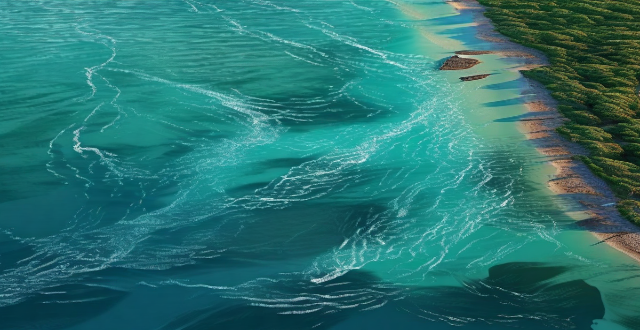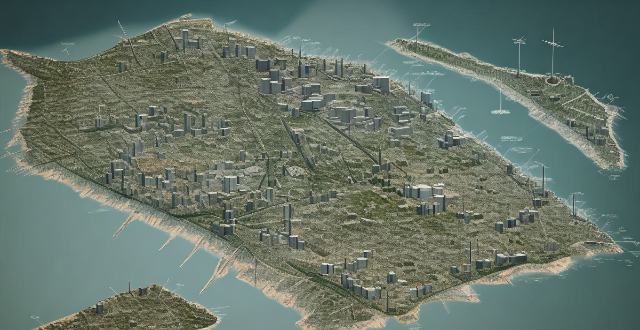Water Coastal

How might rising sea levels due to global warming affect coastal city planning ?
Rising sea levels pose a significant threat to coastal cities, necessitating comprehensive changes in urban planning. These changes include re-evaluating flood risk assessments, implementing coastal protection measures, updating land use planning, enhancing infrastructure resilience, and fostering community engagement. By adopting proactive planning strategies, coastal cities can mitigate the impacts of sea level rise and build more resilient communities for the future.

What are the key sectors that need to focus on climate adaptation ?
The key sectors that need to focus on climate adaptation include agriculture, forestry, coastal areas, water resources, and energy production. In agriculture, crop diversification, water management, and soil conservation are crucial practices. In forestry, sustainable forest management, fire prevention, and biodiversity conservation are essential. Coastal protection, ecosystem restoration, and fisheries management are critical in coastal areas. Water conservation, flood control, and groundwater management are vital for water resources. Finally, investing in renewable energy, improving energy efficiency, and developing carbon capture and storage technologies are crucial for energy production. By focusing on these sectors, we can build resilience against climate change and ensure a sustainable future.

How has global warming impacted sea levels around the world ?
Global warming, primarily caused by greenhouse gas emissions from human activities, has significantly impacted sea levels. This includes melting glaciers and ice sheets, thermal expansion of ocean waters, coastal erosion, saltwater intrusion, increased flooding and storm surge risks, and displacement of coastal communities. Addressing these issues requires both mitigation efforts to reduce emissions and adaptation strategies to cope with the changes already underway.

How does climate change affect the quality and availability of drinking water ?
This article discusses the various ways in which climate change affects the quality and availability of drinking water, including changes in precipitation patterns, melting glaciers, sea level rise, temperature increase, extreme weather events, and wildfires. It also explores adaptation strategies such as water conservation measures, infrastructure improvements, protection of water sources, and policy and regulation to mitigate these risks and ensure a sustainable water future for all.

How does climate change affect water resources and availability ?
Climate change affects water resources and availability through melting glaciers, changes in precipitation patterns, sea level rise, increased evaporation rates, and impacts on ecosystems. These impacts can lead to water scarcity, flooding, contamination of freshwater sources, and declines in biodiversity. To mitigate these effects, it is important to reduce greenhouse gas emissions and implement adaptation strategies such as improved water management and conservation measures.

How is climate change affecting global water resources ?
The impacts of climate change on global water resources include reduced availability due to melting snowpack and glaciers, more frequent droughts and floods, saltwater intrusion into coastal aquifers, and changes in runoff patterns. Water quality is also affected by warmer water temperatures leading to harmful algal blooms, acid rain from increased carbon dioxide levels, pollutant transport from heavy rainfall events, and eutrophication from nutrient loading. The distribution of water resources is impacted by increased water stress in arid regions, migration and displacement of people seeking reliable water sources, strain on infrastructure from extreme weather events, and disruption of aquatic ecosystems due to altered flow regimes. Addressing these challenges requires both mitigation efforts to reduce greenhouse gas emissions and adaptation measures to build resilience against the impacts of climate change on water resources.

How does climate change impact water resource management ?
Climate change significantly impacts water resource management by altering precipitation patterns, increasing evaporation rates, and changing runoff patterns. These changes lead to more variable rainfall, prolonged droughts or intense flooding, reduced snowpack, and earlier spring runoff, among other effects. To adapt, strategies such as water conservation, infrastructure upgrades, integrated planning, ecosystem restoration, and improved monitoring and forecasting are essential for ensuring sustainable water resources amidst a changing climate.

What are the impacts of climate change on sea levels ?
Climate change is causing sea levels to rise, which can have devastating consequences on coastal communities and ecosystems. The melting of ice sheets in Greenland and Antarctica, thermal expansion, loss of coastal wetlands, and increased erosion and flooding are all impacts of climate change on sea levels. It is essential to take action to mitigate the effects of climate change and protect our planet's ecosystems and communities from further harm.

How does sea level rise impact public health, especially in coastal areas ?
Sea level rise, driven by global warming and climate change, poses significant threats to public health in coastal areas through flooding and storm surge, waterborne diseases, environmental health hazards, mental health concerns, economic impacts, and social determinants of health. Addressing this challenge requires a multifaceted approach that includes adaptation strategies, improved infrastructure resilience, and mitigation efforts to reduce greenhouse gas emissions.

How do rising sea levels impact coastal transportation systems ?
The impacts of rising sea levels on coastal transportation systems, including roadways, bridges, port facilities, airports, and railway lines, can be categorized into direct and indirect effects. Direct effects include inundation of low-lying roads and railway tracks, damage to port facilities, vulnerabilities of coastal airports, and degradation of bridges and tunnels due to saltwater intrusion. Indirect effects encompass increased maintenance costs, changes in transportation routes, impact on trade and economy, environmental concerns, and public safety issues. To mitigate these impacts, adaptation strategies such as elevation and retrofitting, relocation, protective measures, flexible design, and improved planning are recommended.

How is climate change affecting coastal areas and small island nations ?
The provided text discusses the various impacts of climate change on coastal areas and small island nations, including increased erosion, displacement of communities, changes in marine ecosystems, extreme weather events, economic impacts, and adaptation challenges. It highlights how these impacts can lead to loss of land area, damage to infrastructure, cultural loss, degradation of coral reefs, habitat loss for marine life, more intense storms, changes in precipitation patterns, threats to the tourism industry, decline in fisheries, limited resources for adaptation measures, and vulnerability of certain populations to health risks and food insecurity.

Where can I find recommendations for a coastal road trip in California ?
California's coastline is a treasure trove for road trippers, with stunning views and diverse attractions. Starting points like San Francisco or Los Angeles offer unique experiences, from exploring iconic landmarks to enjoying the laid-back beach culture. Key highways such as Highway 1 and the Pacific Coast Highway provide access to picturesque towns and natural wonders. Northern California highlights include Mendocino's Victorian charm, Big Sur's majestic landscapes, and Monterey's marine life. Central California offers Hearst Castle's grandeur and San Luis Obispo's historic missions. Southern California beckons with Santa Barbara's sophistication and Los Angeles' entertainment hub. Along the way, enjoy hiking, whale watching, kayaking, and visiting wineries. Plan your trip considering timing, accommodations, weather, and vehicle readiness for a smooth journey.

How does deforestation contribute to water cycle disruption ?
Deforestation contributes to water cycle disruption through soil erosion, surface runoff, and groundwater depletion. This leads to droughts, flooding, pollution, water scarcity, and climate change. Sustainable forest management is crucial to mitigate these effects.

How are coastal cities and communities adapting to the challenges posed by global warming ?
Coastal cities and communities are adapting to global warming challenges through various strategies, including elevated building standards, ecosystem-based adaptation, community planning and education, economic diversification, and policy and legislation. These efforts aim to make these areas more resilient in the face of rising sea levels, increased storm frequency and intensity, and changing precipitation patterns.

How effective are large-scale water transfer projects in alleviating water scarcity ?
Water scarcity is a global issue, and large-scale water transfer projects aim to alleviate it by transporting water from areas with abundant resources to those with scarce ones. These projects can increase water availability, diversify water sources, and provide environmental benefits such as restoring depleted aquifers and wetlands. However, they also face challenges like high costs, negative environmental impacts, and social and political issues. To maximize the benefits of these projects while minimizing their drawbacks, careful consideration of their potential consequences and involvement of all relevant stakeholders in the decision-making process are essential.

How can we improve water resource management in our community ?
The article discusses the importance of water resource management in our community and suggests various strategies to improve it. These include raising awareness through educational campaigns, implementing water-saving measures like fixing leaks and using low-flow fixtures, upgrading infrastructure such as wastewater treatment plants, promoting sustainable practices like xeriscaping and green roofs, and fostering collaborative efforts among different stakeholders. By adopting these approaches, we can ensure the long-term availability of clean water while protecting the environment.

What are the most effective climate adaptation strategies for coastal cities ?
Climate adaptation strategies for coastal cities are essential to mitigate the impacts of climate change such as sea-level rise and storm surges. Effective strategies include building resilient infrastructure, managing coastal ecosystems, enhancing community resilience, and integrating climate considerations into urban planning. These measures aim to protect critical infrastructure, transportation networks, and coastal areas while promoting sustainable development and ensuring the safety of residents.

How does climate change influence job security in coastal regions ?
Climate change significantly impacts job security in coastal regions through direct effects such as sea level rise, increased storm intensity, and changes in ocean temperatures. These environmental changes directly affect industries like fishing, tourism, agriculture, and infrastructure, leading to job losses or reduced hours for employees. Indirectly, climate change can cause economic displacement, public health concerns, and policy changes that create new job opportunities while potentially reducing jobs in other sectors. Addressing these challenges requires coordinated efforts from various stakeholders to adapt to changing conditions and transition towards more resilient economic systems.

How can we balance economic development and water resource protection ?
Water resources are crucial for economic development but must be protected to ensure sustainability. Strategies for balancing these goals include prioritizing sustainable practices, implementing regulatory measures, fostering collaboration and partnerships, investing in infrastructure and technology, and educating and creating awareness. By adopting these approaches, we can achieve a balance between economic growth and water conservation, ensuring long-term sustainability for all.

What are some effective strategies for teaching water safety to children ?
Water safety is an essential skill that every child should learn, especially during the summer months when they are more likely to be around water. Here are some effective strategies for teaching water safety to children: Start early, set clear rules, use visual aids, practice makes perfect, role playing, stay close and supervised, teach risk assessment, and be a good example.

In what ways do dams and reservoirs affect downstream water ecosystems ?
Dams and reservoirs significantly alter downstream water ecosystems by changing water flow, trapping sediments, disrupting nutrient cycles, fragmenting habitats, and affecting biodiversity.

How can I reduce my electricity and water bills ?
To reduce electricity and water bills, one should switchTo reduce electricity and water bills, one should switch, adjust habits like turning off install water-saving fixtures, change bathroom habits, optimize garden watering, and be efficient with laundry and dishes.

How do I overcome my fear of water and learn to swim ?
Overcoming a fear of water and learning to swim is a process that requires patience, persistence, and the right approach. Here's how you can do it: identify the source of your fear, gradually expose yourself to water, find a supportive instructor, start with basics in shallow water, progress slowly, use relaxation techniques, set realistic goals, celebrate small victories, join a swimming group or class, and always prioritize safety.

What are some tips for reducing water consumption at home ?
Reducing water consumption at home can be achieved through various methods, including fixing leaks, installing water-saving fixtures, using efficient appliances, changing habits, being smart with gardening, and monitoring usage. By checking for drips, tightening fixtures, upgrading to low-flow toilets and showerheads, using Energy Star washers and dishwashers, turning off the tap while brushing teeth or shaving, watering the garden in the morning, and regularly reading the water meter, households can save money on utility bills and contribute to a more sustainable environment.